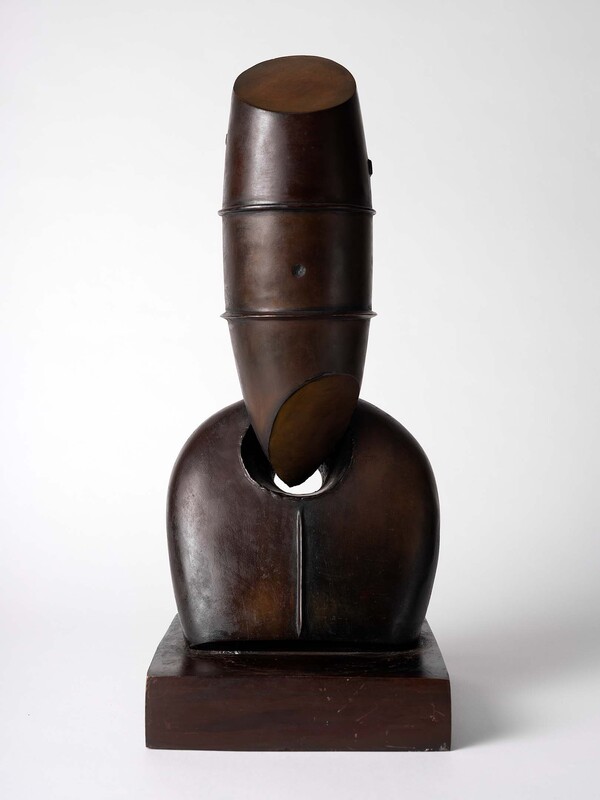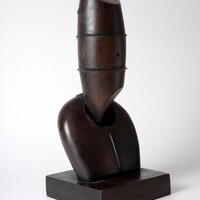MCA.SMCA.C528
Item
Αντικείμενο/ Έργο
- Κωδικός έργου
- MCA.SMCA.C528
- Είδος έργου/ Τύπος τεκμηρίου
- el Γλυπτό
- en Sculpture
- Μουσείο
- el Μουσείο Σύγχρονης Τέχνης
- en Museum of Contemporary Art
- Συλλογή
- el Δωρεά ΟΠΠΕΘ '97
- en OPPETH '97 Donation
Θέμα
- Θέμα: Ταξινόμηση αντικειμένου/ έργου (Ύφος/ Τάση/ Ομάδες/ Κινήματα)
- el Αφηρημένη σύνθεση
- el Γλυπτική
- en Abstract composition
- en Sculpture
- el Σύγχρονη τέχνη
- en Contemporary art
Τίτλοι ή Ονόματα
- Τίτλος έργου
- el Χώρος, Υποκείμενο, Αντικείμενο
- en Space, Subject, Object
Δημιουργία
- Δημιουργός
- el Χατζηιωαννίδης, Φώτης (1940)
- en Chatziioannides, Fotis (1940)
Μετρήσεις
- Ύψος σε εκατοστά
- 44
- Πλάτος σε εκατοστά
- 20
- Μήκος σε εκατοστά
- 19
Υλικά και Τεχνικές
- Υλικά
- el Χαλκός
- en Copper
- Τεχνικές
- el Γλυπτική
- en Sculpture
Καρτέλα Κατάστασης Έργου/ Συντήρηση
- Περιγραφή συντήρησης
- Καλή κατάσταση
Περιγραφή αντικειμένου
- Περιγραφή έργου
- el Οι μορφές του Φώτη Χατζηιωαννίδη διακρίνονται για τη στιβαρότητά τους. Συχνά μετουσιώνουν το όραμα της ένωσης μέσα από φόρμες που εισέχουν, εξέχουν, έλκονται, ενώ όπως στην περίπτωση του έργου «Χώρος, Υποκείμενο, Αντικείμενο», όπου η σύνθεση μπορεί αρχικά να εκληφθεί ως προτομή, παραπέμπει σε φαλλικό σύμβολο, τονίζοντας τα χαρακτηριστικά του ανδρικού φύλου και τη γυμνότητα.
- en The figures of Fotis Chatziionannides are distinguished for their robustness. They often transfigure the vision of union through forms that enter, protrude, and attract, while, as in the case of the work "Space, Subject, Object", where the composition can initially be understood as a bust, it refers to a phallic symbol, emphasizing the characteristics of the male sex and nudity.
Δημιουργός
- Συνοπτικό βιογραφικό δημιουργού
-
el
Γεννήθηκε στην Ξάνθη το 1940. Σπούδασε γλυπτική στην Α.Σ.Κ.Τ. (1959-1965). Το 1971 μετακόμισε στο Βερολίνο, όπου πραγματοποίησε σπουδές γλυπτικής στη Staatliche Hochschule für bildende Kunst (1972-1977) με δάσκαλο τον B. Heiliger. Στη συνέχεια επέστρεψε στην Ελλάδα και από το 1988 εκλέχθηκε καθηγητής και δίδαξε στη Σχολή Καλών Τεχνών του Α.Π.Θ.
Η εξαιρετική επεξεργασία και ανάδειξη της υφής του υλικού (κυρίως χαλκού), η σχηματοποίηση και η συμβίωση αρχών που εκτείνονται από την κλασική έως τη σύγχρονη τέχνη, χαρακτηρίζουν τη γλυπτική του, που έχει ως κέντρο την ανθρώπινη μορφή και πιο συγκεκριμένα τον κορμό της, το torso, το οποίο, μέσα από διαδοχικές μεταπλάσεις και αφαιρέσεις, το συσχετίζει με φυσικά ή τεχνητά σχήματα. Όταν οι «Κορμοί» του παραπέμπουν όχι μόνο σε ανθρώπινες μορφές αλλά και σε κορμούς δέντρων ή εξαρτήματα μηχανών, γίνεται εμφανής η πρόθεσή του να αποδώσει τη δυναμική ενέργεια του κόσμου, την ενότητα ανθρώπου-φύσης-τεχνολογίας, ενώ οι συνθέσεις του αποπνέουν ένα διάχυτο ερωτισμό με φόρμες που ανακαλούν τα χαρακτηριστικά του φύλου. -
en
He was born in Xanthi in 1940. He studied sculpture at the Athens School of Fine Arts (A.F.S.A) (1959-1965). In 1971 he moved to Berlin, where he studied sculpture at the Staatliche Hochschule für bildende Kunst (1972-1977) with B. Heiliger. He then returned to Greece and since 1988 he was elected professor and taught at the School of Fine Arts of the Aristotle University of Thessaloniki.
His sculpture is characterized by the exceptional treatment and the textural qualities of the material (mainly copper), the shaping and the symbiosis of principles ranging from classical to contemporary art, which is centred on the human form and more specifically on the torso, which, through successive metamorphoses and abstractions, he relates to natural or artificial shapes. When his "Torsos" refer not only to human forms but also to tree trunks or machine parts, his intention to convey the dynamic energy of the world, the unity of man-nature-technology, becomes evident, while his compositions exude a pervasive eroticism with forms that recall the characteristics of gender.
Αξία/ Εκτίμηση
- Αξία ασφάλισης
- 2.500
- Μονάδα
- el Ευρώ
Τρέχουσα θέση/ φύλαξη
- Όνομα χώρου αποθήκευσης/ Γεωγραφική θέση
- el MOMus-Μουσείο Μοντέρνας Τέχνης-Συλλογή Κωστάκη, Κολοκοτρώνη 21, 56430 Σταυρούπολη
- Αριθμός αποθήκης
- el Αποθήκη Α1 (αριστερή)
- Παλιός κωδικός
- D-1674
- TH-0005
- Κωδικός Pictura: ΟΠΠΕΘ085
Ιδιοκτησία συλλογής
- Τρόπος απόκτησης
- el Δωρεά
- Προέλευση online
- el Δωρεά του Ο.Π.Π.Ε.Θ. '97
- en Donation of the Cultural Capital of Europe Thessaloniki '97 Organization
- Λεπτομέρειες προέλευσης
- Δωρεά του Ο.Π.Π.Ε.Θ. '97 προς το ΚΜΣΤ
Βιβλιογραφία
- Βιβλιογραφία
- ● Λεξικό Ελλήνων Καλλιτεχνών. Ζωγράφοι, Γλύπτες, Χαράκτες, 16ος-20ός αιώνας, τόμ. 4, σελ. 396 (Αθήνα: Εκδοτικός Οίκος Μέλισσα, 2000). Κ. Κιλεσσοπούλου: Ο καλλιτέχνης χρησιμοποιεί στα έργα του αρχές της κλασικής τέχνης και μέσα από τις αφομοιωμένες επιρροές της ευρωπαϊκής γλυπτικής του 20ου αιώνα-κυρίως από τον H. Moore- διαμορφώνει το γλυπτικό του ιδίωμα. Αφετηρία στο έργο του είναι ο ακρωτηριασμός της κλασικής φόρμας -με τη δημιουργία κορμών χωρίς άκρα- και η σύγκρουση ανθρώπου-φύσης-μηχανής. Οι μορφές του διακρίνονται για την ευρωστία τους.
- ● Κατάλογος ατομικής έκθεσης, Παλαιό Αρχαιολογικό Μουσείο-Γενί Τζαμί, κείμ. Κ. Κιλεσοπούλου, Θεσσαλονίκη 1989.
- ● Κατάλογος ατομικής έκθεσης, The Hakone Open-Air Museum, Τόκιο 1991.
- ● Κατάλογος ατομικής έκθεσης, «Titanium», Αθήνα 1994.
- ● Κατάλογος ατομικής έκθεσης, «Artforum», Θεσσαλονίκη 1995.
- ● Κατάλογος ατομικής έκθεσης, «Αστρολάβος», Αθήνα 1998.
Τεκμηριωτής/ Συντελεστής
- Τεκμηριωτής/ Συντελεστής
- Έλενα Κεχαγιά



